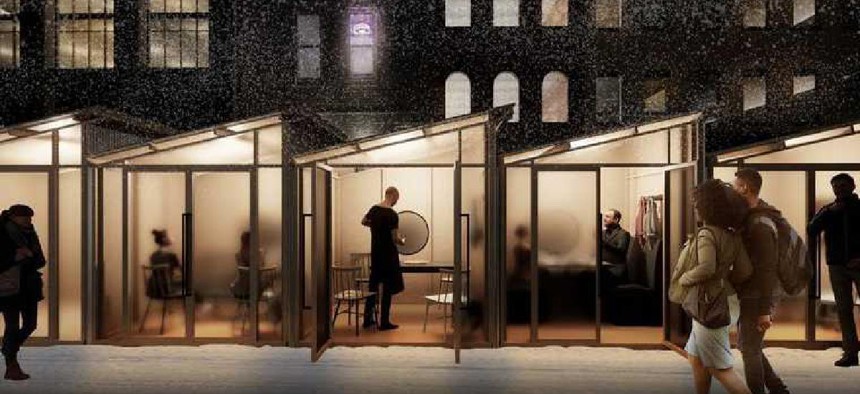Chicago launches a challenge to extend outdoor dining into winter

As COVID-19 continues to upend local economies, the Windy City is getting creative to support the restaurant sector.

Cozy Cabins, one of the winning proposals in the City of Chicago's Winter Design Challenge (Image: Amy Young)
Ever since they first started in government in the early 2000s at DARPA, I have been a big fan of what academics and many in the business world call "contests" and what we in government, with our penchant for home-grown terms, have given the moniker "challenges." As many blog readers may remember, I have lauded these as the classic form of performance-based contracting (companies are paid only for success) and also, because they involve doing rather than proposal writing, are a great way to bring non-traditional players into the federal marketplace.
As time has gone by, the significance of the topics that are the object of challenges has increased. At the beginning (with the exception of the all-terrain vehicle that got the innovation started), many of these were quite trivial, like designing an agency logo. But they have more recently moved up the value chain. For example, VA had a contest to develop ideas for dealing with veteran suicide.
Now, however, the idea has for the first time migrated to a dinner-table issue, at least in wintry areas in the north. During the pandemic, many cities do not allow indoor dining. Outdoor dining has been a very popular economic (for restaurants) and quality of life (for patrons) lifeline in the warm weather and is likely to continue in much larger numbers post-pandemic. But especially in the wintertime, if outdoor dining – which traditionally shuts down in the winter – is not feasible, then the economics of many restaurants are not feasible either.
The City of Chicago took the initiative to organize a "Winter Design Challenge," soliciting ideas for outdoor eating spaces appropriate to winter. Anyone could enter. Three winners would be chosen, with a prize of $5,000 per winner but more importantly free publicity for one’s design abilities and the possibility of selling to restaurants for use.
Less than three months later (compare that to a normal procurement process!) over 600 entries had been received . Bidders entered only a prototype – no written proposal, no knowledge of the procurement process required. The city paid nothing to the bidders for their work – the prototypes were funded by the bidders themselves.
Two preliminary rounds of judging by the city and the renowned design firm IDEO produced 26 finalists. According to an article in The Chicago Tribuneabout the contest, the finalist presented their prototypes to a panel of judges made up of architects, designers, chefs, restaurateurs and servers (a nice touch).
Two of the three winners finally announced were definitely non-traditional players in government contracting: one an urban planner who is adjunct faculty at Northwestern, and another a local graphic designer. (The third works at an architectural firm.)
One winner (calling itself "Cozy cabin") used small, modular, adjoining cabins with radiant floor heating fitting into a standard street parking space. The structures feature transparent windows to make "diners feel part of the community while safely social distancing from other diners." Each cabin also has a vent near the ceiling for air circulation, and is constructed with furniture, walls and floors that can be cleaned between guests. The cabins are ADA-accessible.
Another winner, whose designer had worked in Japan, featured a low table (think Japanese restaurant) covered by a blanket that also has a small electric heater on its underside. An additional table top is placed on top of the blanket to hold more food.
IDEO will now work with the Illinois Restaurant Association to pick construction firms for "design development and technical refinement" on the winners. The Restaurant Association will pick pilot restaurants to testing these solutions. Construction of the pilots will be paid by a Chicago bank.
Like challenges in general, this idea is not for everyone. But anyone interested in thinking outside the procurement box, and bringing in out-of-the-box vendors at very low cost to the government, should really be looking for opportunities here.
NEXT STORY: COVID-19 made IT modernization a priority





